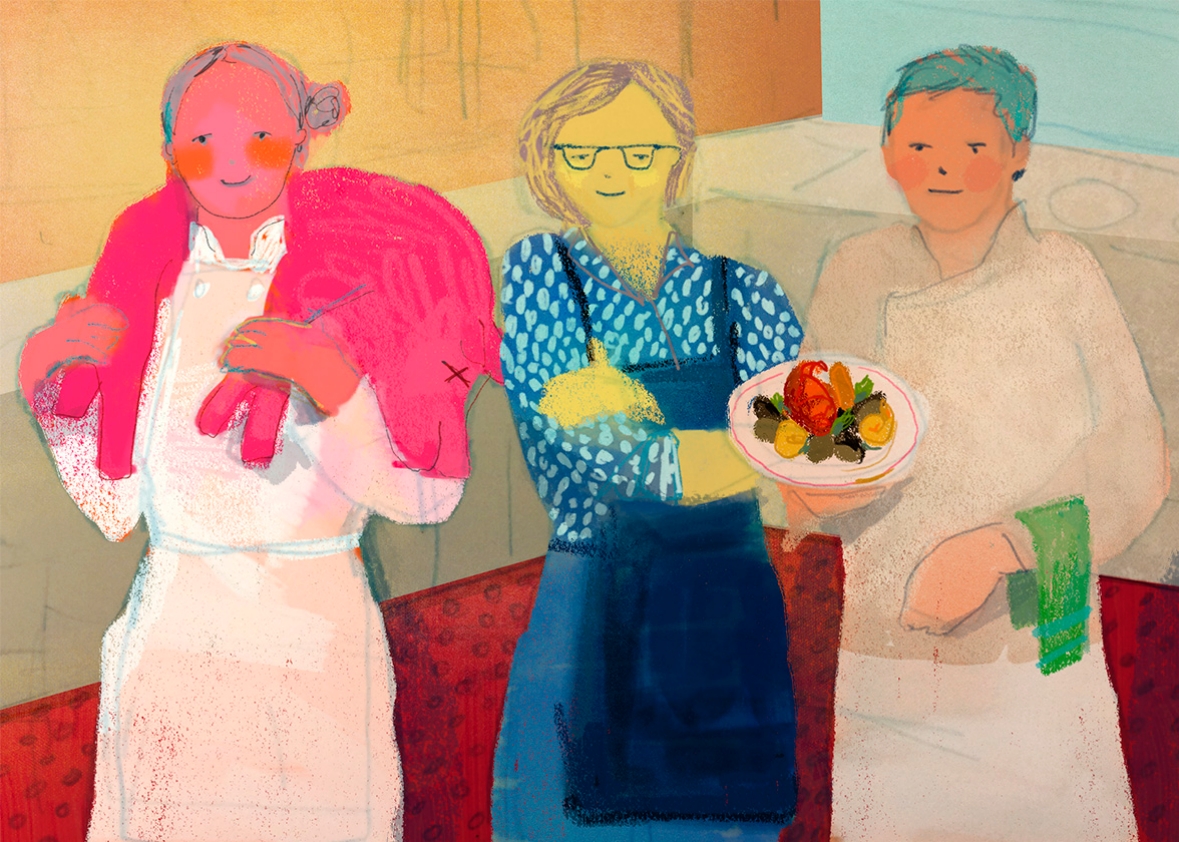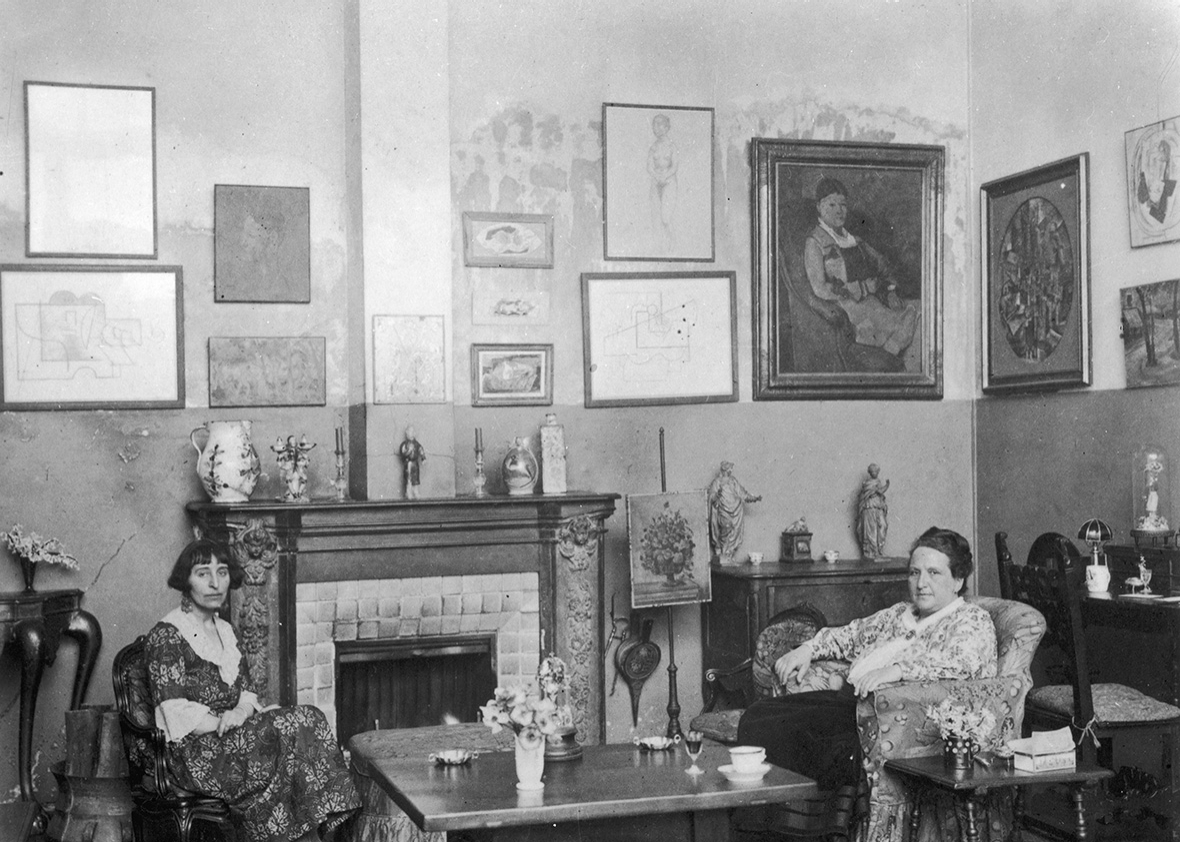The Joy of Gay Cooking: Of Cozy Lesbians, Colonialist Bros, and the Missing Gay Chefs

Illustration by Lisa Larson-Walker.
Unfortunately, the intrepid soul searching for the joy of gay cooking in the restaurant scene will have trouble finding it: Gay male chefs may be more commonly out now than in the past, but they are still (with the notable exception of cooking show contestants) keeping a very low public profile. In 2012, the Advocate ran an article called “Queers in the Kitchen” that addressed this issue in great detail, but it doesn’t seem that much has improved since then. In general, gay cooks are still more likely to try to compensate their otherness by working twice as hard (to avoid being singled out) than to flaunt their gayness at work. Some people may be as freaked out by the idea of a gay kitchen as they still are by the idea of gays in the military, but the politically correct attitude these days is to say that sexual orientation shouldn’t affect your work. I beg to differ—identity can absolutely impact one’s work. For a case study, behold the new guard of high-profile, proudly out lesbian chefs.
In her 2015 keynote address at Jubilee, a culinary conference produced by the women’s food magazine Cherry Bombe, chef and restaurateur April Bloomfield, who is casually open about being a lesbian, talked about her original dream of becoming a cop. Joking about how, growing up in England, she had been inspired by a television series that featured female cops who “kicked ass,” she reasoned that what had attracted her to law enforcement was not only her desire to bring justice and peace to the needy, but also an attraction to working within a clearly structured, hierarchical, close-knit community. When her application to the English police academy was turned down, she spontaneously decided to follow in the footsteps of her two older sisters and go to culinary school instead.
|
The Child, the Bear,
the Queen, and the Artist |
||
|
The Straightening of American Cooking
|
||
|
The Terrible Reign of the Iron Chef
|
||
|
Cozy Lesbians and Colonialist Bros
|
||
|
The Art of Simplisissyty
|
Speaking at the conference, Bloomfield did not elaborate on the fact that both law enforcement and the professional kitchen environment are essentially masculine worlds, but I couldn’t help noticing her preoccupation with the uniforms that come with both territories. Wanting to understand Bloomfield’s apparent attraction to the idea of wearing a uniform, I spoke with Madeleine Kemble, a friend and out-lesbian cook who works at a fancy restaurant in the Flat Iron District. She poignantly explained to me that for many lesbians, the no-frills uniform of a chef is very much in sync with their lifelong refusal to conform to gender ideals that call on women to appeal to the male eye and don accouterments like high heels, tight-fitting dresses, push-up bras, make-up, and elaborate hairdos. From this point of view, the professional rationale of a uniform is a welcome excuse to dress down and avoid sexist objectification: “Kitchen-folk, for the sake of their jobs, need to dress sensibly and efficiently for the tasks of the day,” Kemble told me. “Our whites give us space from the frills of the floor and help us focus on the presentation of our food rather than ourselves.”
In other words, it seems that women like Kemble and Bloomfield like to disappear behind their uniforms in order to be judged not by their appearance but by their work ethic, their skills, and their efficiency. They tend to focus on the essentials—quality and substance—and, unlike stereotypical gay males (the sort who find careers as interior decorators, hair stylists, fashion designers, floral designers, caterers, and makeup artists), do not like to fuss around with decorum, appearances, and presentation. In terms of food, this translates into something very distinct, refreshingly unassuming, and sophisticated in its simplicity. Which is precisely why I have, for many years, been instinctively drawn to restaurants that happen to be owned and run by lesbian chefs.
In their firm and able hands, I am stirred by a distinct sensation that I am eating food that’s been prepared by someone who not only relishes what she is doing but who is neither into showing off nor likely to overburden my plate or my palate. Dining in lesbian-run restaurants gives me the sense of visiting a comfortable but uncluttered and, most important, clean house—perhaps not the most stylish, but pleasantly unpretentious. The food is usually rather conservative in nature, close to home and heartwarmingly self-confident. Having dinner at the counter at my favorite New York restaurant, Pearl Oyster Bar, I can watch chef and owner Rebecca Charles deftly massage crumbled parmesan cheese, croutons, and just the right amount of dressing into torn leaves of romaine for the best Caesar salad in town before eating a whole grilled dorade that is stuffed with fresh herbs and a sliver of garlic, none of which I will let go to waste. An imposing figure in khaki shorts and chef’s whites, sleeves rolled up, she surveys the dining room with her sharp eyes like a watchful mom, a force to be reckoned with and a master of the ultimate achievement of any chef: A perfect balance between restraint and indulgence.
A few blocks over, at Jody Williams’ Buvette, I can get a carefully assembled French version of a ham and cheese sandwich with a fried egg known as Croque Madame that makes me swoon with every bite as it magically manages to be rich without being overwhelming, despite a discreetly tucked-in second egg. (Note the name of the dish and the fact that Williams puts two “Madames” into hers—now that’s sophisticated lesbian cooking. Her girlfriend by the way, Rita Sodi, is also a chef and restaurant owner, and the two Madames co-own the Tuscan-style gastroteca Via Carota just down the street from Buvette.)
Another few blocks away (but still well within the cozy residential part of the West Village, Manhattan’s historical home front for gays and lesbians), at The Spotted Pig, April Bloomfield proves that her notoriously popular nose-to-tail approach to cooking easily extends to working with vegetables, which she treats with the same characteristic aplomb—think of it as root-to-flower eating. A recent visit rewarded me with a delectable salad of charred radicchio di Treviso with burrata, and I have since then already toyed several times with her recipe for crushed spring peas with mint, featured in her new vegetable-centric cookbook, A Girl and Her Greens.
The sensual yet robust nature of the food served by these three highly distinct and openly lesbian women makes me think of Alice B. Toklas and the robust recipes she featured in her legendary cookbook. I can taste a sense of calm authority with every bite; lesbian cooking gives me a kind of lingering, glowing pleasure. More sunset than fireworks, it is the culinary equivalent of a long and extended orgasm, something these women must know a lot about, just like Alice B. in the hands of Gertrude Stein, who lovingly called her “Pussy.” As Etta James sang: Just come to Mama.

Photo by Fotosearch/Getty Images
How different then are the pleasures at the straight end of the spectrum of restaurant cooking? Look, for example, to one of the new-fangled pan-Asian or otherwise vaguely exotic restaurants in gentrified Williamsburg or on the Lower East Side, where swashbuckling male chefs extoll their colonial mastery of the cuisines of the Far East and beyond as if they wanted us to share in their experience of backpacking around the globe: cheap, basic accommodations, lots of casual sex with willing females, few showers, no need to shave, plenty of beer and recreational drugs, and exceedingly spicy food that reeks of fermentation and literally screams umami. Here, the theme song is Guns N' Roses’s “Welcome to the Jungle”—loud and uninhibited.
The food produced from this philosophy is so recklessly saturated with salt, fat, sugar, funk, and hot spice that one cannot help but going into sensory remission after a while, falling into a state of moronic haze, very much wanting to collapse for a half hour under the table before braving the long, long way home. Many may enjoy this kind of food as a subliminal kind of fast and furious sex; but then, we all know the kind of man who brags about his sexual prowess, only to deliver the sloppiest sort of intercourse. That’s what this kind of food reminds me of—on a good day. On a bad day, it’s more akin to date rape.
I wish there was a gay male equivalent to compare these culinary experiences to out there, but I have yet to hear of a high-profile restaurant chef who is openly, publicly gay. As popular fascination with professional cooking continues to grow, I hope that someday soon, it will not only be perfectly normal for gay chefs to be out of the closet, but that we will all fully embrace the fact that our individual identity and desires, gay or straight, are always reflected in our work. This kind of acceptance would do much to empower gay male chefs to not hold anything back and to begin to actively influence the way professional kitchens are run (with more gentleness and less bad-ass posturing), as well as to insist on having a more active stake in the the kind of food that comes out of them (a bit more balance between meat and vegetables would go a long way in my gay book).
But we’re not there yet. Notwithstanding the refreshing community of lesbian chefs and their sensual, direct approach to cooking, the food world is still largely ruled by three fractions: the male chauvinists, the earnest do-gooders (many of them laughing all the way to the bank by selling an image of perfection via cheap merchandise), and the literal-minded science geeks who treat the kitchen like a chemical lab, washing away any remaining sensuality with sanitizer and formulas. A stronger presence of gay men on the scene would loosen their collective grip on the public’s imagination and introduce an alternative approach to cooking that, as we shall see, might serve it much better.
Next course: How to cook gaily at home—whether you’re gay or not!
*Correction, July 17, 2015: Due to a labeling error by a photo provider, the date in the caption for the photo of Gertrude Stein and Alice B. Toklas was incorrect in the original version of this post.
